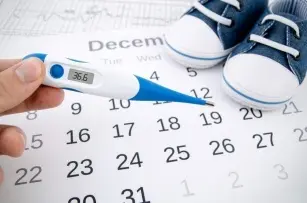
First of all, the fertile days are the days when fertilization can occur after intercourse.
We are usually aware of the fact that the ovum dies after several dozen hours, and that sperm can survive for 2 days or even longer. Studies in this respect have shown that in healthy women fertile days are already 5 days before ovulation and on the day of ovulation, but the probability of fertilization also exists 2 days after ovulation and 6-8 days before it, it is admittedly less than 5%, but always bear this fact in mind. The highest chances of implantation of the zygote, depending on the woman’s age, occur 2-3 days before ovulation and amount to as much as 50%.
Then one question comes to mind, how to predict these days? It is worth knowing the answer to them, both when trying to conceive and when we want to avoid conception.
In a natural way, we can calculate when our fertile days fall out in several proven and confirmed ways.
First – cervical mucus assessment – is a method that allows us to assess when the fertile days began and ended. The mucus before and during ovulation is sticky and stretchy, while after ovulation it is dry and thick. The effectiveness of using this method ranges from 78% to even 97% if we follow all its recommendations.
Another method is symptom-thermal It involves the observation of more than one indicator of a woman’s fertility. Temperature and cervical mucus are usually measured. There are several techniques in this method. When used correctly, it provides effectiveness comparable to intrauterine devices, i.e. 99,4% -99,8%.
There is also a lactation method for postpartum infertility. It reaches up to 99% efficiency. However, certain conditions should be met:
- the child should not be older than 6 months
- menstruation should not yet occur
- and the baby should be exclusively breastfed, on demand, at least every 4 hours during the day and 6 hours at night.
However, the length of this infertile period is unpredictable because the new cycle begins with ovulation, not bleeding.
Thermal method instead, it consists in making regular, daily measurements of the woman’s body temperature. The measurement should be taken in the morning before getting up, regularly at the same time. In this way, a graph is created that shows that after menstruation the body temperature is low, then there is a rapid increase and the temperature remains elevated for about 3 days. Then we can determine when our fertile days occur, because it is 6 days before the high temperature and 3 days after. The other days are infertile.
Currently, the thermal method can be effectively modernized using a cycle computer, which, when used correctly, can be compared to hormonal contraception. They definitely improve the comfort of using the thermal method, and also improve its measurement.









